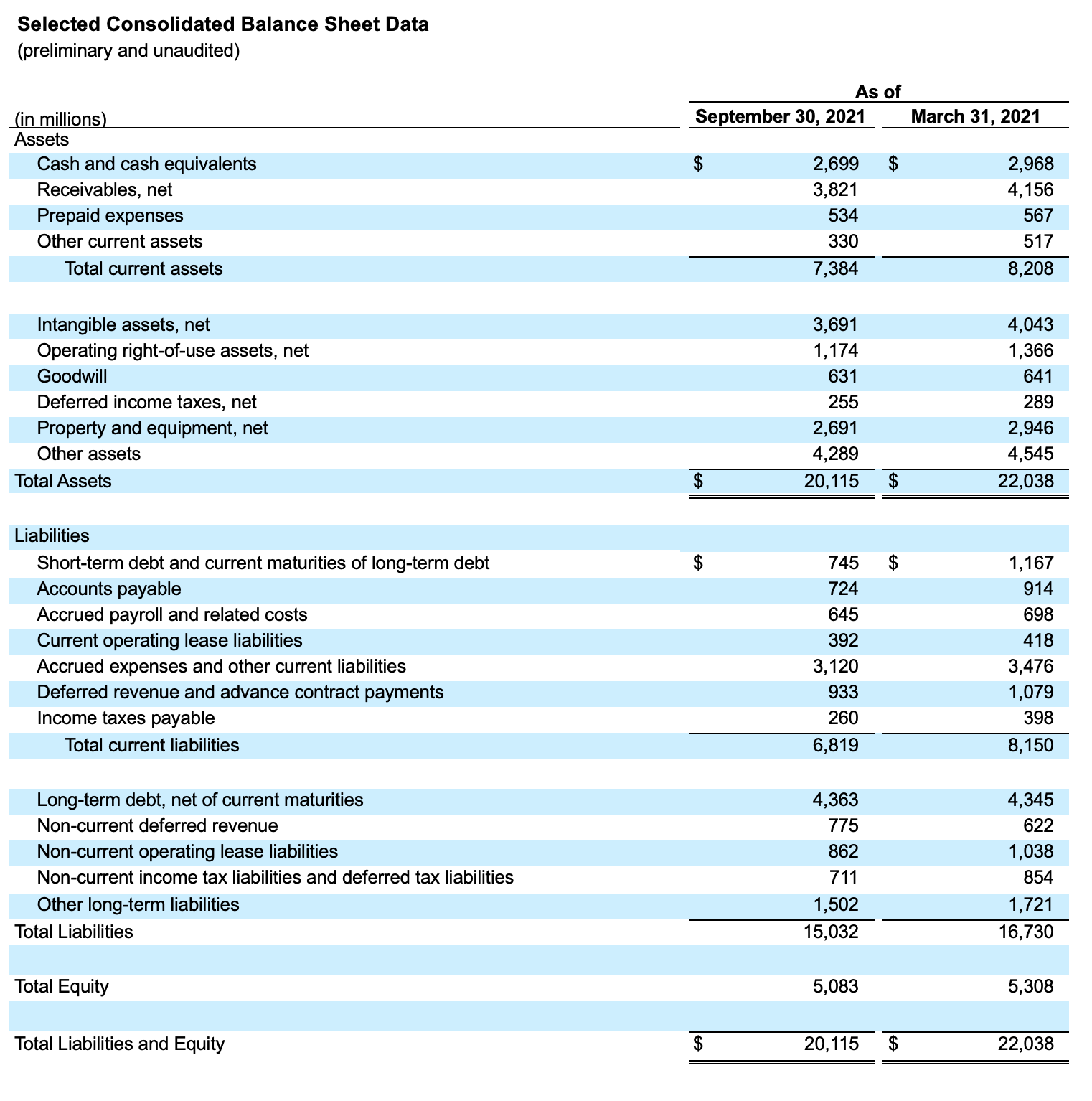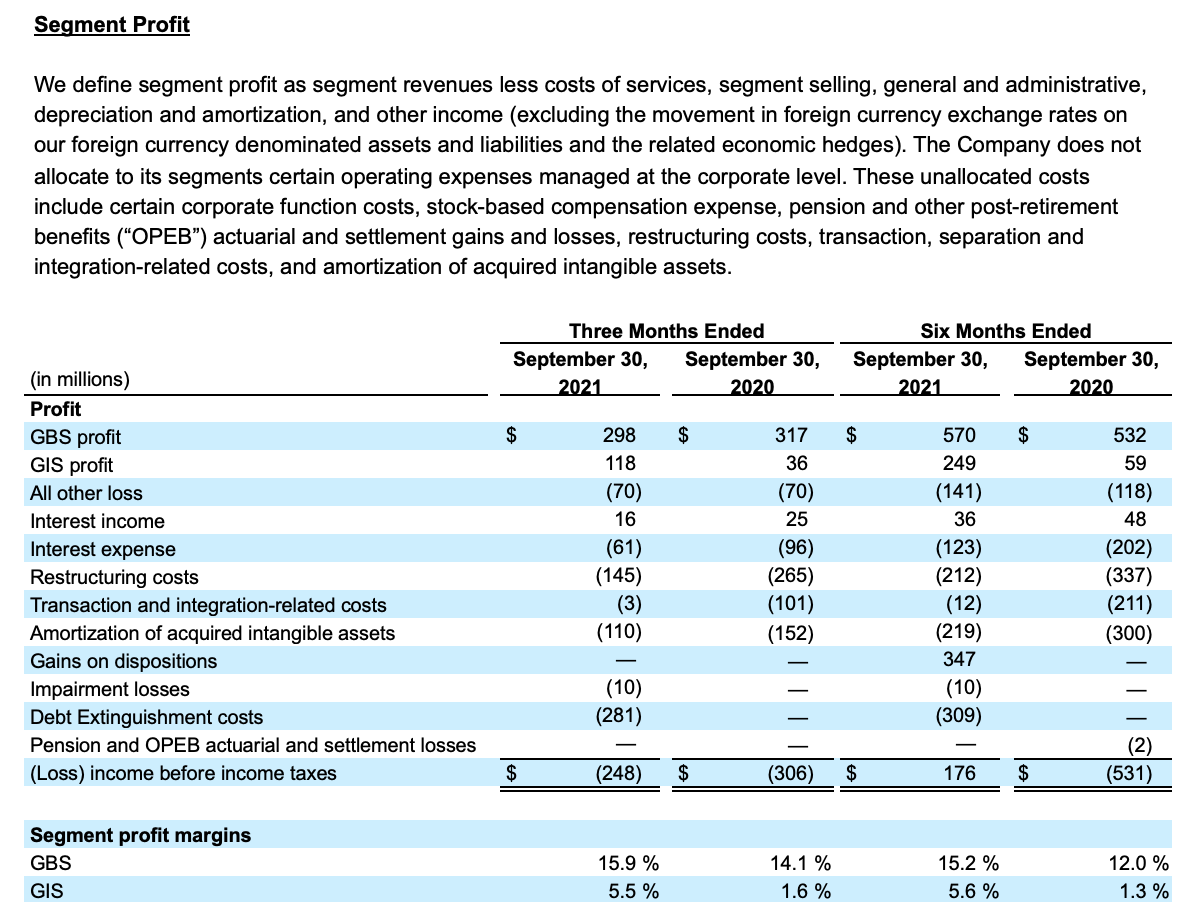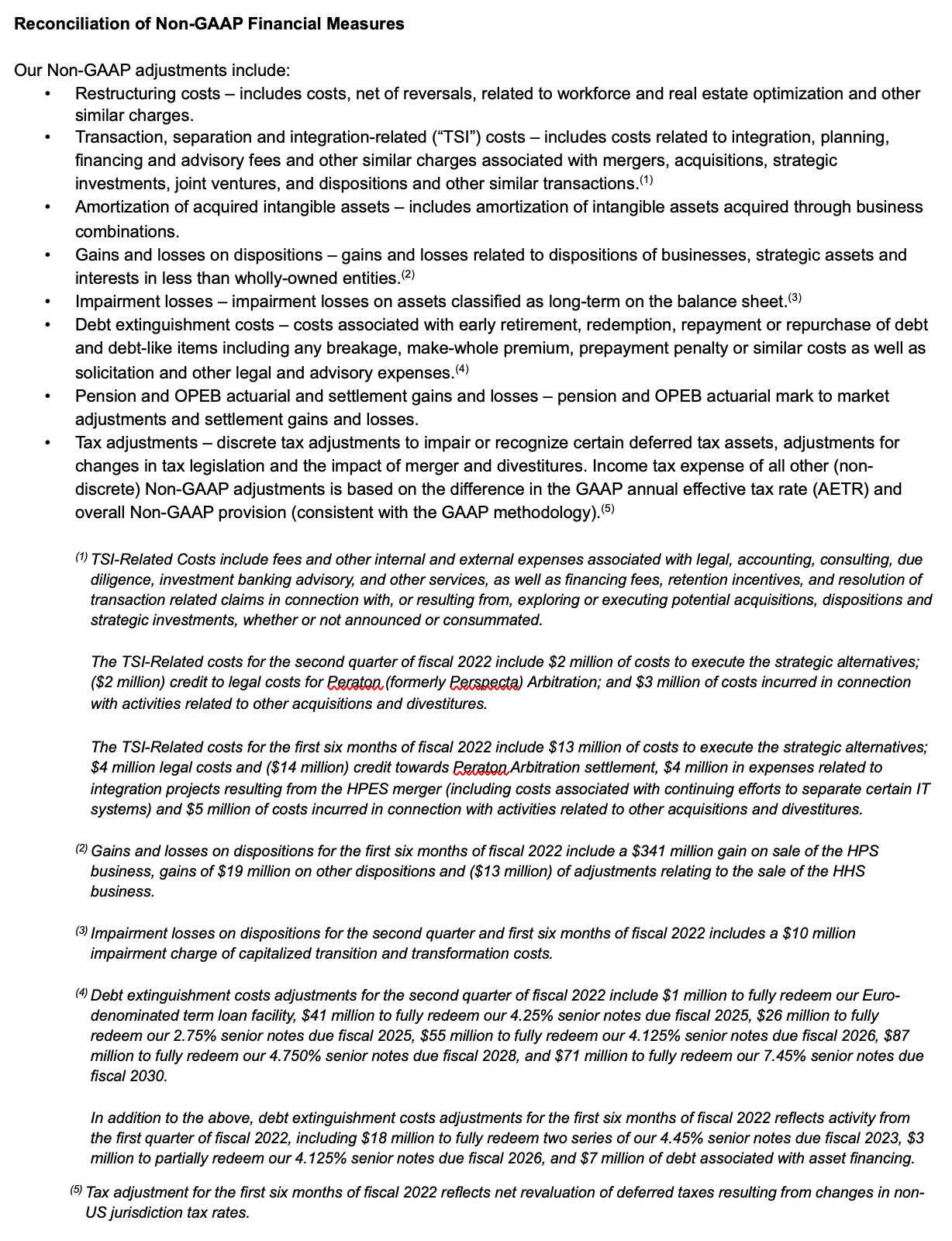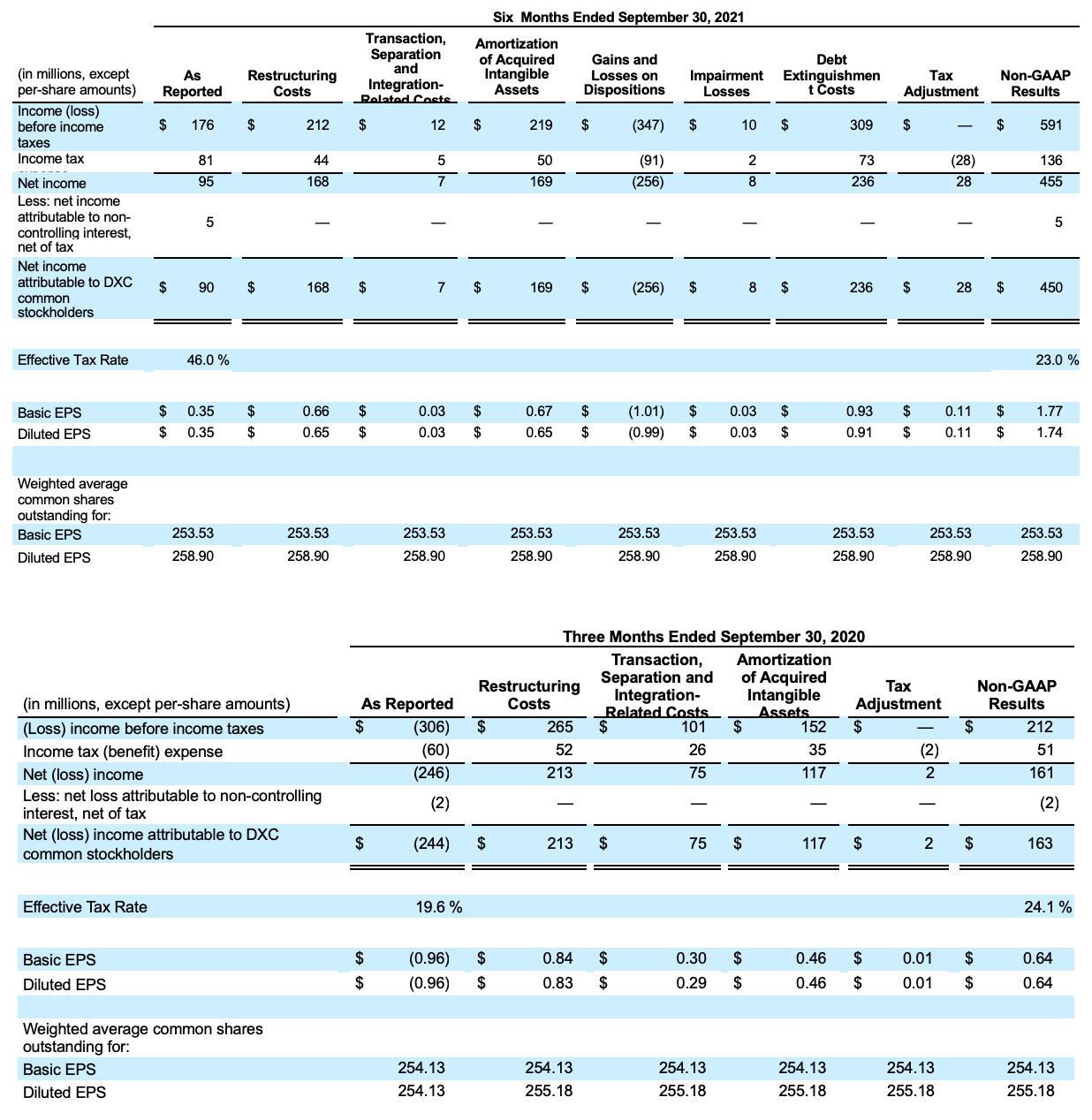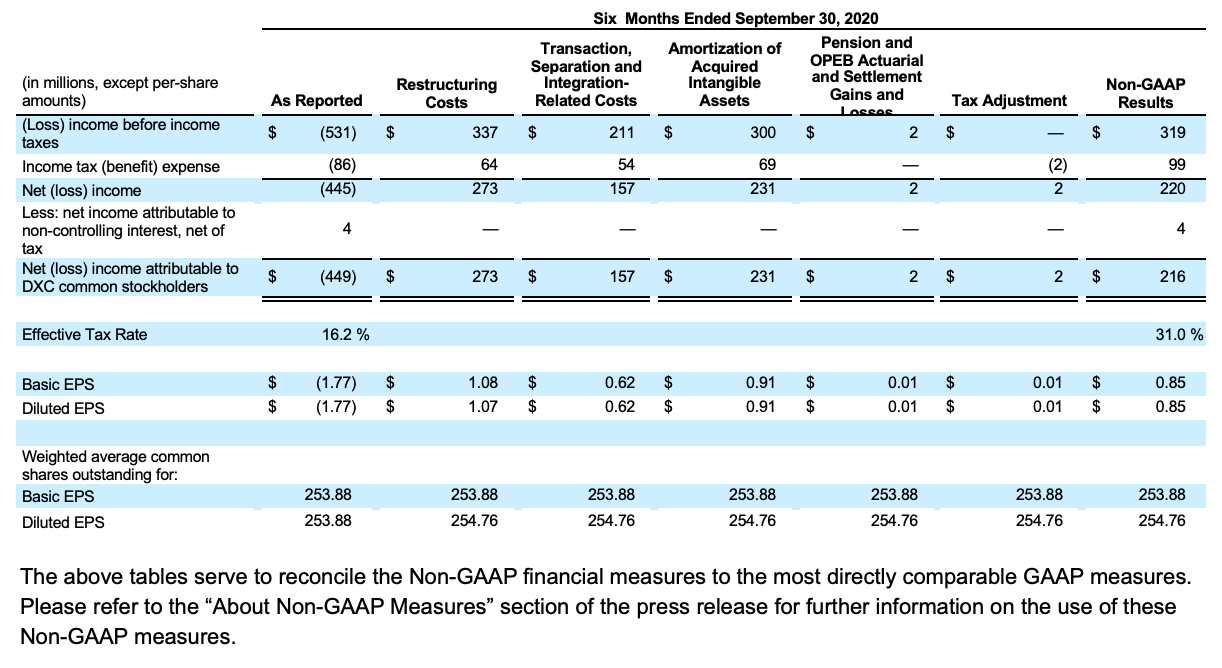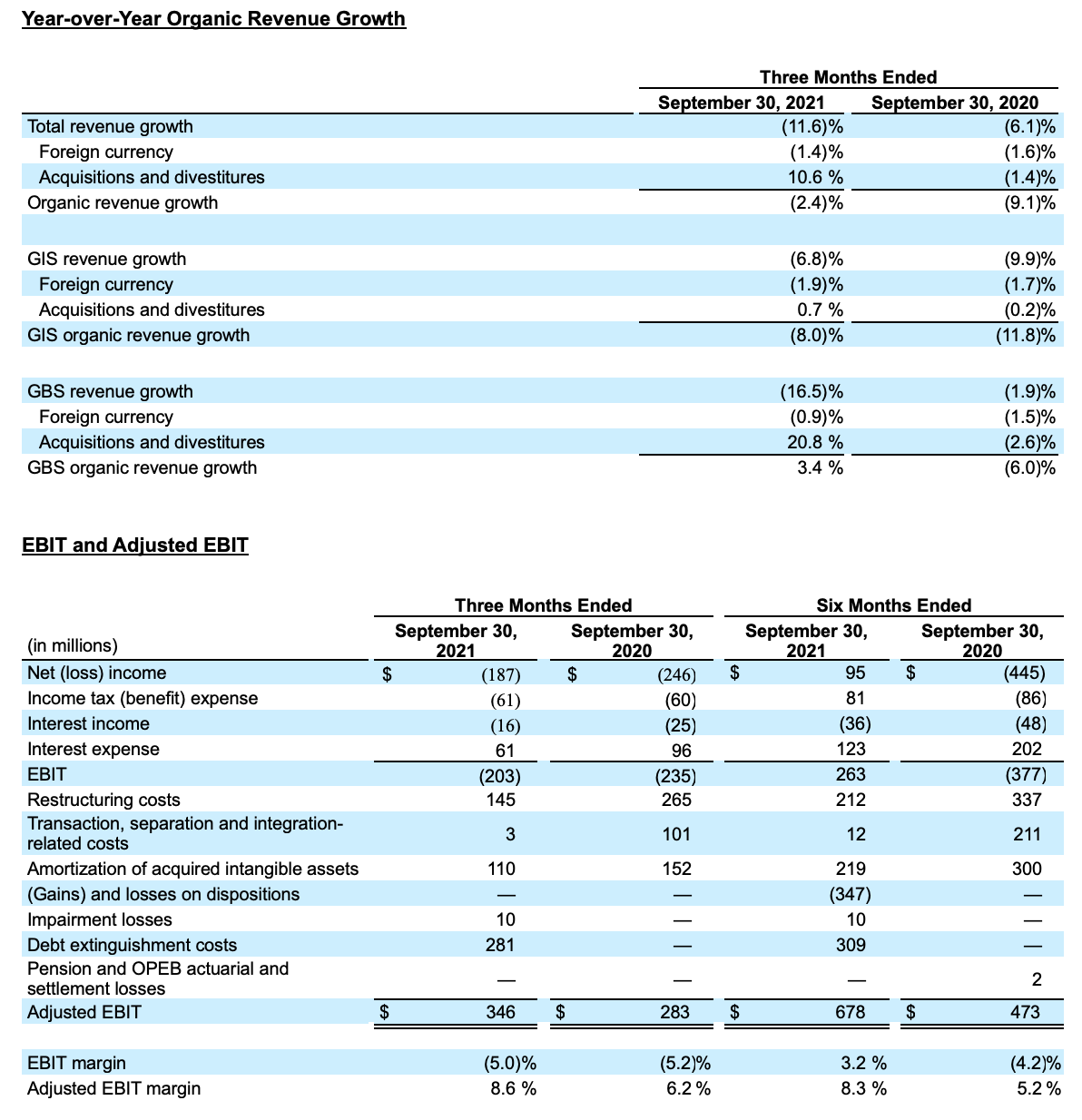DXC Technology Reports Second Quarter Fiscal Year 2022 Results
- Revenues of $4.03 billion, down 11.6% as compared to prior year, and down 2.4% on an organic basis
- Diluted EPS was $(0.74) compared to $(0.96) in the prior year quarter. Non-GAAP diluted EPS was $0.90, up 41% compared to $0.64 in Q2 FY21
- Cash flow from operations was $563 million and free cash flow was $404 million in the second quarter
- Increasing FY22 Non-GAAP diluted EPS and increasing FY22 Adjusted EBIT margin guidance ranges. Reducing FY22 revenue guidance range due to foreign exchange fluctuations
- Bookings of $3.7 billion and book-to-bill ratio of 0.91x in Q2 FY22
TYSONS, Va., November 3, 2021 – DXC Technology (NYSE: DXC) today reported results for the second quarter fiscal year 2022.
“We are clearly executing on 'the build the foundation phase' of our playbook. I am particularly pleased with the progress that we have made in delivering on our financial foundation, which includes decreasing our debt levels, lowering restructuring and TSI expense, increasing our Adjusted EBIT margins and Non-GAAP EPS and delivering strong free cash flow,” said Mike Salvino, DXC President and Chief Executive Officer. “In addition, our customers are at the highest level of satisfaction since I have been here, and based on our September engagement survey, our colleagues are engaged and motivated. I remain encouraged by our improving organic revenue growth trends, and in particular, the progress we are making in driving organic growth in Global Business Services and the improving organic revenue trajectory of our Global Infrastructure Services.”
Financial Highlights - Second Quarter of Fiscal Year 2022
Revenue was $4.03 billion, down 11.6% as compared to prior year, and down 2.4% on an organic basis. Second quarter revenues came in below the previous guidance range, as the strengthening of the U.S. dollar reduced second quarter fiscal year 2022 revenues by $59 million as compared to the currency rates used in our prior earnings guidance.
Net loss was $(187) million compared to $(246) million in the prior year quarter. EBIT was $(203) million or (5.0)% of sales. Net loss and EBIT in the quarter included the following items: amortization of intangible assets of $110 million, debt extinguishment costs of $281 million, restructuring costs of $145 million, other impairment losses of $10 million, and transaction, separation, and integration costs of $3 million. Excluding these items, Adjusted EBIT margin was 8.6% in the second quarter, an improvement of 240 bps as compared to the prior year quarter. Second quarter Adjusted EBIT margin came in above our guidance range.
Diluted loss per share was $0.74 and Non-GAAP diluted earnings per share was $0.90 in the second quarter of fiscal year 2022, driven by the improvement in margins, lower interest expense, and a lower tax rate. Non-GAAP EPS exceeded the Company's previous guidance range.
Book-to-bill for the quarter was 0.91x, which was below management’s longer-term goal of 1.0x, due to the timing of new work. In the first half of fiscal 2022, the company delivered a book to bill of 1.02x.
During the second quarter, the Company repurchased 2.1 million shares of common stock for a total of $83 million. Year-to-date, the company repurchased 3.9 million shares for a total of $150 million.
Financial Information by Segment
GBS segment revenue was $1.873 billion in the second quarter of fiscal year 2022, down 16.5% compared to prior year, but up 3.4% on an organic basis. GBS segment profit was $298 million and segment profit margin was 15.9%, up 180 bps as compared to the second quarter of fiscal year 2021. GBS bookings for the quarter were $1.72 billion for a book-to-bill of 0.92x.
GIS segment revenue was $2.154 billion in the second quarter of fiscal year 2022, down 6.8% compared to prior year, and down 8.0% on an organic basis. GIS segment profit was $118 million with a segment profit margin of 5.5%, a 390 bps margin expansion as compared to second quarter of fiscal year 2021. GIS bookings were $2.0 billion in the quarter for a book-to-bill of 0.91x.
Enterprise Technology Stack Highlights
The components of the Enterprise Technology Stack are as follows:
Cash Flow
Cash flow from operations was $563 million in the second quarter of fiscal year 2022, and capital expenditures were $159 million. Free cash flow (cash flow from operations, less capital expenditures) was $404 million in the second quarter of FY22, as compared to $303 million in the second quarter of FY21. Second quarter FY22 cash flow included a tax payment of $160 million related to divestitures and cash outflows related to the refinancing of the Company’s high coupon debt.
Guidance
The Company's guidance for the third quarter and full fiscal year 2022 is as follows:
The Company reaffirmed its longer-term guidance:
- Positive organic revenue growth of 1% to 3% for fiscal year 2024
- Adjusted EBIT margin of 10% to 11% in fiscal year 2024
- Non-GAAP diluted EPS of $5.00 to $5.25 in fiscal year 2024
- Free cash flow of approximately $1.5 billion in fiscal year 2024
- Restructuring and TSI of approximately $100 million in fiscal year 2024
DXC does not provide a reconciliation of Non-GAAP measures that it discusses as part of its guidance because certain significant information required for such reconciliation is not available without unreasonable efforts or at all, including, most notably, the impact of significant non-recurring items. Without this information, DXC does not believe that a reconciliation would be meaningful.
Ken Sharp, Chief Financial Officer, commented: “The second quarter of fiscal year 2022 saw continued progress toward building our strong financial foundation for DXC. Our recent refinancing extends debt maturities, lowers maturity towers, and reduces ongoing interest expense by approximately $50 million annually. We continue to significantly reduce restructuring and TSI expense, lower capital lease payments, reduce our facility footprint and drive our ongoing cost optimization program. Taken together, these initiatives are driving an improvement in DXC's free cash flow generation capability."
Earnings Conference Call and Webcast
DXC Technology senior management will host a conference call and webcast to discuss these results on November 3, 2021, at 5:00 p.m. EDT. The dial-in number for domestic callers is +1 (888) 510-2008. Callers who reside outside of the United States should dial +1 (646) 960-0306. The passcode for all participants is 9312260. The webcast audio and any presentation slides will be available on DXC Technology’s Investor Relations website.
A replay of the conference call will be available from approximately two hours after the conclusion of the call until November 17, 2021. Phone number for the replay is +1 (800) 770-2030 or +1 (647) 362-9199. The replay passcode is 9312260.
About DXC Technology
DXC Technology (NYSE: DXC) helps global companies run their mission critical systems and operations while modernizing IT, optimizing data architectures, and ensuring security and scalability across public, private and hybrid clouds. The world’s largest companies and public sector organizations trust DXC to deploy services across the Enterprise Technology Stack to drive new levels of performance, competitiveness, and customer experience. Learn more about how we deliver excellence for our customers and colleagues at DXC.com.
Forward-Looking Statements
All statements in this press release that do not directly and exclusively relate to historical facts constitute “forward-looking statements.” Forward-looking statements often include words such as “anticipates,” “believes,” “estimates,” “expects,” “forecast,” “goal,” “intends,” “objective,” “plans,” “projects,” “strategy,” “target,” and “will” and words and terms of similar substance in discussions of future operating or financial performance. Forward-looking statements include, among other things, statements with respect to our future financial condition, results of operations, cash flows, business strategies, operating efficiencies or synergies, divestitures, competitive position, growth opportunities, share repurchases, dividend payments, plans and objectives of management and other matters.
These statements represent current expectations and beliefs, and no assurance can be given that the results described in such statements will be achieved. Such statements are subject to numerous assumptions, risks, uncertainties and other factors that could cause actual results to differ materially from those described in such statements, many of which are outside of our control. Furthermore, many of these risks and uncertainties are currently amplified by and may continue to be amplified by or may, in the future, be amplified by, the coronavirus disease 2019 (“COVID-19”) pandemic and the impact of varying private and governmental responses that affect our customers, employees, vendors and the economies and communities where they operate. For a written description of these factors, see the section titled “Risk Factors” in DXC’s Annual Report on Form 10-K for the fiscal year ended March 31, 2021, and any updating information in subsequent SEC filings, including DXC’s upcoming Quarterly Report on Form 10-Q for the quarterly period ended September 30, 2021.
No assurance can be given that any goal or plan set forth in any forward-looking statement can or will be achieved, and readers are cautioned not to place undue reliance on such statements which speak only as of the date they are made. We do not undertake any obligation to update or release any revisions to any forward-looking statement or to report any events or circumstances after the date of this presentation or to reflect the occurrence of unanticipated events except as required by law.
About Non-GAAP Measures
In an effort to provide investors with supplemental financial information, in addition to the preliminary and unaudited financial information presented on a GAAP basis, we have also disclosed in this press release preliminary Non-GAAP information including: earnings before interest and taxes ("EBIT"), EBIT margin, Adjusted EBIT, Adjusted EBIT margin, Non-GAAP income before income taxes, Non-GAAP net income, Non-GAAP diluted EPS, organic revenues, organic revenue growth, and free cash flow.
We believe EBIT, EBIT margin, Adjusted EBIT, Adjusted EBIT margin, Non-GAAP income before income taxes, Non-GAAP net income and Non-GAAP diluted EPS provide investors with useful supplemental information about our operating performance after excluding certain categories of expenses. Free cash flow represents cash flow from operations, less capital expenditures.
One category of expenses excluded from Adjusted EBIT, Adjusted EBIT margin, Non-GAAP income from continuing operations before tax, Non-GAAP net income and Non-GAAP diluted EPS, incremental amortization of intangible assets acquired through business combinations, may result in a significant difference in period over period amortization expense on a GAAP basis. We exclude amortization of certain acquired intangible assets as these non-cash amounts are inconsistent in amount and frequency and are significantly impacted by the timing and/or size of acquisitions. Although DXC management excludes amortization of acquired intangible assets primarily customer-related intangible assets, from its Non-GAAP expenses, we believe that it is important for investors to understand that such intangible assets were recorded as part of purchase accounting and support revenue generation. Any future transactions may result in a change to the acquired intangible asset balances and associated amortization expense.
Another category of expenses excluded from Adjusted EBIT, Adjusted EBIT margin, Non-GAAP income from continuing operations before tax, Non-GAAP net income and Non-GAAP diluted EPS, impairment losses, may result in a significant difference in period over period expense on a GAAP basis. We exclude impairment losses as these non-cash amounts, reflect generally an acceleration of what would be multiple periods of expense and do not expect to occur frequently. Further assets such as goodwill may be significantly impacted by market conditions outside of management’s control.
We believe organic revenue growth provides investors with useful supplemental information about our revenues after excluding the effect of currency exchange rate fluctuations for currencies other than U.S. dollars and the effects of acquisitions and divestitures in the periods presented. See below for a description of the methodology we use to present organic revenues.
Selected references are made to revenue growth on an “organic basis” so that certain financial results can be viewed without the impact of fluctuations in foreign currency rates and without the impacts of acquisitions and divestitures from “organic basis” financial results, thereby providing comparisons of operating performance from period to period of the business that we have owned during all periods presented. Organic revenue growth is calculated by dividing the year-over-year change in GAAP revenues attributed to organic growth by the GAAP revenues reported in the prior comparable period. This approach is used for all results where the functional currency is not the U.S. dollar.
There are limitations to the use of the Non-GAAP financial measures presented in this report. One of the limitations is that they do not reflect complete financial results. We compensate for this limitation by providing a reconciliation between our Non-GAAP financial measures and the respective most directly comparable financial measure calculated and presented in accordance with GAAP. Additionally, other companies, including companies in our industry, may calculate Non-GAAP financial measures differently than we do, limiting the usefulness of those measures for comparative purposes between companies.

